Text
Smelt mystery in the Great Lakes
In 2021, Wisconsin fish researchers identified a big mystery in a tiny fish. Sampling data from rainbow smelt caught in Lake Superior showed unusually high levels of perfluorooctane sulfonate (PFOS), a harmful chemical that is part of a group of compounds known as per- and polyfluorinated substances (PFAS). As a result, both Wisconsin and Michigan notified the public about this discovery and issued a Consumption Advisory which included the risks of eating those fish too often.
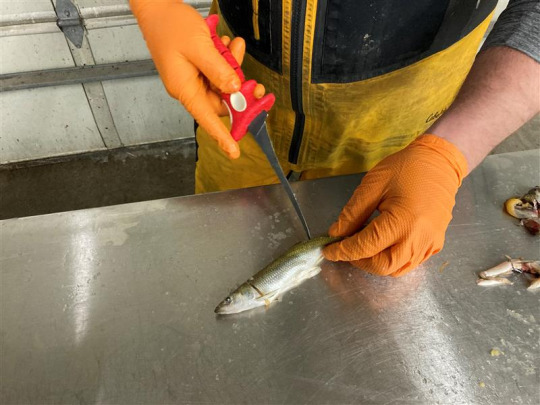
These high levels of PFOS in these little smelt raised questions for state scientists – “Where did this PFOS come from?” and “Why was it so high in smelt?” There were many possible reasons to be investigated. It was possible that the amount of PFOS in Lake Superior varied around the lake; it was possible that smelt had a feeding behavior that exposed them to greater amount of PFOS than other fish; or it was possible that smelt retained PFOS more than other Lake Superior fish. It has long been known that PFOS bioaccumulates differently in fish than other persistent chemicals (such as mercury), and that fish lower in the food chain can have some of the highest PFOS concentrations.These questions led the Michigan PFAS Action Response Team, MPART, scientists on a three-year journey that involved collaboration with Tribal governments, Great Lake States, and the U.S. Environmental Protection Agency (EPA). Based on Wisconsin’s initial results, MPART conducted sampling to also evaluate smelt within Lake Superior. The Michigan smelt results mirrored those found in Wisconsin, however, other researchers had results that showed much lower levels of PFOS in Lake Superior smelt.Scientists shared data and observed that a specific sub-type of PFOS called “branched-PFOS” was high in Michigan data but not in the other researchers’ data sets.In 2023, scientists from EPA sought to determine why smelt from Lake Superior had drastically lower PFOS concentrations along the northern shorelines compared to those collected from the southern shorelines. Reviewing all the Lake Superior smelt data available, they surmised that a naturally occurring bile acid in smelt, known as taurodeoxycholic acid (TDCA), could be interfering with the laboratory method. This interference could cause branched-PFOS to be reported in much higher amounts than is actually present in the smelt.According to EPA, TDCA/bile acids have nearly the same molecular mass as branched-PFOS in addition to containing a sulfonate group, another marker for PFOS. Because of those characteristics, the lab equipment couldn’t previously separate the bile acids from the branched-PFOS.Michigan has reanalyzed some smelt samples with a new lab method and found low-levels of branched-PFOS and confirmed that bile acids were interfering with the branched-PFOS levels. The reanalyzed smelt samples had PFOS concentrations in line with those being reported by the other researchers.“Providing answers to these complex PFAS questions can only be solved in cooperation with our many partners” Abby Hendershott, MPART executive director, said. “The collaboration and data sharing between Great Lakes partners have led to this major finding.” Michigan will be using the reanalyzed data to update the 2024 Eat Safe Fish Guidelines in accordance with their fish consumption programs.“For the past 50 years, the Eat Safe Fish Guidelines have been designed to be protective of everyone, including the most sensitive populations,” said Dr. Natasha Bagdasarian, chief medical executive. “Michigan continues to be a national leader in PFAS research and understanding and will continue directing resources to protect Michiganders from PFAS and other contaminants.”MPART will continue to collaborate with federal and state agencies, Tribal governments and academia to use the best methods to understand this group of chemicals as the science evolves.
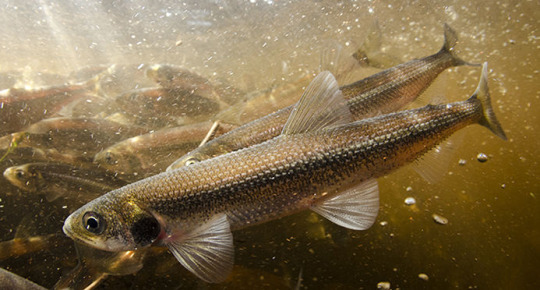
Source: EGLE Newsroom
#environmentaleducation#protectourwaterways#protectourplanet#cleanwater#pollution prevention#michigan#egle#great lakes#greatlakes#environmental education
0 notes
Text
Food Waste Prevention Week
As part of Food Waste Prevention Week, MI Environment is highlighting two Michigan municipalities that are offering residents ways to reduce their food waste by keeping it out of landfills.

Spurt Industries' screening plant, where compost is screened, creating a better finished product and removing clumps in the soil. The equipment also separates and removes large pieces of wood that did not fully decompose and filters out contaminants like plastic and metal. Courtesy of My Green Michigan.
Landfilled food is one of the biggest sources of methane, a key driver of climate change. So it's not a surprise that the state’s MI Healthy Climate Plan has a goal of cutting the amount of landfilled food in half by 2030.
But with more than two billion pounds of food going to Michigan landfills each year, cutting that in half in only six years is a big lift. That is where Southfield and Wixom come in to help foster innovation in the food space. Because Southeast Michigan is the most populated area of the state, addressing food waste is expected to have a major impact on the overall state goal.
Make Food Not Waste, along with 17 local and national partners, is taking food waste head on by defining what it takes to divert all of a city's food waste from landfills, starting with the city of Southfield. The Make Food Not Waste team is creating a detailed plan that incorporates all of the best practices in food waste reduction from around the country. The plan will include recommendations for source reduction, food rescue, upcycling, and organics recycling.
The approach underscores two important points: first, there is no "one" solution to food waste; and second, stopping food from going into landfills only happens by working together.
By early fall, the group will have a detailed map outlining the communication, infrastructure, and logistical needs to divert all of Southfield's food waste to alternate uses detailed in EGLE’s Sustainable Food Hierarchy. With that in place, the plan can be replicated in other highly populated cities. If it sounds ambitious, it is.
Make Food Not Waste, an environmental non-profit based in Detroit, is a recipient of an EGLE Zero Food Waste Pilot grant to tackle this goal. Read about The 2030 Project to learn more.
Another city starting a food scrap program is Wixom. Beginning this week, Wixom is making it easy for residents to have food scraps and yard waste collected weekly curbside. The scraps and yard waste will be composted and used in gardens and city projects.
Acceptable food scraps include fruits and vegetables, dairy products, meats, bones, eggshells, coffee grounds and filters, tea leaves and tea bags, paper napkins and paper towels (free of chemical cleaners), breads, grains, and spoiled food from the refrigerator.
The city is partnering with Spurt Industries, Green for Life, and Resource Recovery and Recycling Authority of Southwest Oakland County (RRASOC) for this program. Check out RRASOC Wixom Food Scrap Program webpage to learn more.
“Efforts by Michigan cities are key to achieving Michigan’s food waste reduction strategy,” said Jeff Spencer, a manager in the EGLE’s Materials Management Division. “Southfield and Wixom are pioneers in this effort. EGLE expects other cities to follow in the footsteps of the work initiated by these progressive communities.”
EGLE continues to prioritize programming for food waste reduction to work toward meeting the MI Healthy Climate Plan goal of a 50% food waste reduction, through the Catalyst Communities Initiative, NextCycle Michigan, and in partnership with Michigan Green Communities (MGC). NextCycle Michigan has eight teams currently working through the Foods, Liquids, & Organic Waste Systems (FLOWS) Accelerator track. MGC will be hosting a webinar "Developing a Baseline Estimate for Food Waste in Your Community" on April 11, and on May15 the Catalyst Communities Initiative will host a Food Waste Workshop for local governments as a MI Healthy Climate Conference pre-Conference event.
Check out EGLE’s Food Waste webpage to learn more.
Source: EGLE Newsroom
0 notes
Text
Fix a Leak Week March 18-24
Take the 10-minute challenge during Fix a Leak Week
Did you know that, according to the EPA, the average household loses more than 10,000 gallons of water each year through leaks? That’s about 270 loads of laundry! Some water leaks are slow and difficult to detect, yet even the smallest leaks can add up quickly.

Fortunately, most leaks are easy to find if you know where to look, and many common household leaks are easy to fix, requiring only a few tools and hardware that can pay for themselves in water savings.
This Fix a Leak Week, take 10 minutes to find and fix leaks in your home.
Use EPA’s at-home checklist to walk through your home and check places where leaks commonly occur.
Fix a Leak Week is a national campaign, created by the U.S. Environmental Protection Agency (EPA) and supported by WaterSense partners across the U.S. and Canada, aimed at educating residents on the importance of fixing plumbing leaks to save money on water and energy bills. Michigan will recognize Fix a Leak Week from March 18 to 24.
EGLE's Office of the Clean Water Public Advocate encourages Michiganders to find and fix leaks within their home and share information about leaks with others during Fix a Leak Week. Check out Michigan.gov/FixALeakWeek for some practical tips on finding and fixing household leaks, materials you can share on social media, and educational resources to get kids engaged. If you decide to get involved, share a photo and tag your post with #FixALeakWeek.
Finding and fixing leaks can save money and energy and reduce potential public health risks for you and your community. It takes a lot of energy to deliver and treat the water you use every day. By repairing leaks, you reduce energy and water waste, which can lower your bills.
Water is part of what makes us love Michigan (the Great Lakes are the largest fresh surface water system on earth, and don’t forget what’s underneath us – groundwater!). It’s important to be good stewards to this amazing resource that surrounds us.
For more information, including video tutorials on fixing common household leaks, visit the EPA’s Fix a Leak Week page. If you've already determined you have leaks and these resources aren't enough to stop them, it might be time to contact a plumbing professional. When replacing fixtures, consider those with a WaterSense label, which could increase your home's water efficiency and lower your bill.
For more information, visit Michigan.gov/FixALeakWeek.

Source: EGLE Newsroom
0 notes
Text
Cleaning up Michigan's scrap tires
Year after year, Michigan’s Scrap Tire Program rolls on: In 2023, the program cleaned up over 507,000 passenger tires – more than 126,000 four-wheeled vehicles’ worth – with a few efforts yet to be tallied.

In Michigan, is it illegal to dispose of whole motor vehicle tires in landfills. Instead, the Scrap Tire Program administered by the Michigan Department of Environment, Great Lakes, and Energy (EGLE) regulates proper disposal, transportation, and storage, as well as cleanup of existing scrap piles of 500 or more tires. Scrap tire transporters and collection sites must register each year, and program staff regularly inspect scrap tire collection sites, processors, end users, and generators, including tire dealers and auto scrap yards.
Why? Because improper management of scrap tires can be hazardous to the environment and public health, not to mention unsightly. Runoff from hard-to-extinguish tire fires can contaminate water, and scrap tires are an ideal breeding ground for mosquitoes that carry disease such as West Nile Virus.
In the October 2022-September 2023 fiscal year (FY), the program tallied 408 inspections related to collection sites, haulers, retailers, grants, and complaints.
Cleanups in FY 2023 involved 97 grants totaling nearly $1.4 million. Seven – including two carried over from the previous year – were for privately owned sites. For the cleanup and recycling of tires determined to have been dumped or collected after 1991 on private sites, grants are subject to repayment. Of the 90 community cleanups, five did not end up using any funding.
EGLE has approved 135 applications for 2024 cleanup grants in 75 of Michigan’s 83 counties.
Michigan generates more than 10 million scrap tires a year. These tires can be turned into mulch, tire-derived fuel, incorporated into road pavement, shredded and used for aggregate in backfill and drain fields, and to manufacture new tires and plastics.
Find a list of tire recyclers and processors that accept tires from the public at Michigan.gov/ScrapTires. Many tire retailers also accept used tires for a small fee or when new tires are purchased.
Source: EGLE Newsroom
#protectourwaterways#protectourplanet#cleanwater#pollution prevention#michigan#egle#great lakes#greatlakes
0 notes
Text
Chemical Spill in Bear Creek
The second round of water samples taken from Bear Creek near a plating company responsible for a chemical release to the creek confirms the presence of per- and polyfluoroalkyl substances (PFAS), cyanide and heavy metals downstream from the release.
Samples showed elevated levels of some chemicals, but not at concentrations that would pose a risk to humans when people contact with creek water and/or sediment. Specifically, copper and cyanide were present in levels above those established to protect aquatic life. Concentrations of PFOS – part of the PFAS family – were slightly elevated.
Officials stress there was no impact to drinking water systems from the release, although all areas water systems were alerted as a precaution. Test results released by the Mt. Clemens water system – the closest system to where the Clinton River enters Lake St. Clair – showed no indication of elevated pollutants in drinking water.
Officials continue to advise caution against prolonged contact with creek waters and sediments as other contaminants and bacteria unrelated to the spill could be present and the creek is not a recreation area.
The samples were collected and analyzed by the Michigan Department of Environment, Great Lakes, and Energy (EGLE). EGLE will use the sampling data to assess the impact to Bear Creek, determine next steps to ensure the protection of the environment, and will continue to work with the Michigan Department of Health and Human Services to ensure the protection of human health.
Contractors hired by the property owner continue to work on site cleanup plans under the oversight of EGLE, which continues to investigate the circumstances of the release.
It is suspected to have begun when a water line in the former Fini-Finish Metal Finishing plating shop broke on Jan. 24 causing an estimated 580,000 gallons of water to flood the shop, located at 24657 Mound Rd. As a result, chemicals associated with the plating business entered storm sewers that flow into Bear Creek. The creek flows into the Red Run Drain and then the Clinton River, which is a tributary to Lake St. Clair.
The US Environmental Protection Agency (EPA) led the cleanup effort and turned the site over to Michigan EGLE last weekend for follow-through. Visit EPAs incident page for more information. EGLE’s test data is available at the Bear Creek Spill page.
The EGLE samples were taken from throughout Bear Creek and Red Run Drain.
The chemicals identified in the downstream creek waters likely included those released from the facility, mixed with other water in this heavily urbanized stream that typically carries some industrial pollutants.
EGLE continues to investigate the circumstances of the release and is monitoring the property owner’s removal of the chemicals from inside the facility.
Determinations on potential violations, penalties and fines will be made after the investigation’s conclusion, which could take several more weeks.

source: EGLE Newsroom
#cleanwater#pollution prevention#michigan#environmental education#protectourplanet#egle#great lakes#greatlakes
0 notes
Text
Michigan's Critical Dune Areas
Michigan’s Critical Dune Area’s are part of the largest collection of freshwater dunes in the world. Their unique combination of topography, climate, and vegetation only occurs in the Great Lakes region. EGLE’s latest story map dives into the diversity, quality, and functions of the dunes and how the State is working to protect them.

Michigan’s sand dunes are a unique natural resource of global significance. They represent the largest collection of freshwater dunes in the world.
The combination of topographic relief, vegetation and climate are only found in Michigan. The dunes support a wide diversity of habitats from temperate coastal forests of maple and hemlock trees to the harsh environment of the open dunes, to quiet interdunal ponds found in dune and swale complexes. These natural communities support many threatened or endangered plants and animals.Michigan's dunes play an important role in our quality of life and economy. the critical dune areas preserve the coastal dune resource by regulating the impacts from development. Sand dune mining has long supported industry and manufacturing.
The natural communities found in Michigan’s dunes support numerous threatened or endangered species.
The Pitcher’s Thistle is a flowering plant that thrives in the hot and windy beaches and open dunes. This plant is easily trampled highlighting the importance of staying on marked trails.
The Piping Plover is a small shore bird that feeds and nests on beaches. There are three distinct populations in North America including one that nests and breeds only along the shores of the Great Lakes. These birds rely on having natural, unarmored, sandy beaches for their survival. A complete list of Michigan’s threatened, and endangered species is available at the Michigan Natural Features Inventory.

Critical Dune Areas, or CDAs, have been protected by the State of Michigan since 1989 when the Sand Dunes Protection and Management Act was passed. Today EGLE’s Water Resources Division is charged with protecting these globally significant areas. Regulations balance protecting the dunes for present and future generations with the many benefits they provide such as economic development, tourism, and recreation.
Highlights of the story map include:
Exploring CDAs in each of the 19 counties where they are found.
Seeing how the topography of the dunes influences plant communities.
Learning about the endangered (and adorable) piping plover.
Visualizing the benefits of an uninterrupted flow of sand along and across the shoreline.
Discovering how everyone, including those who don’t live in the CDA, can protect the dunes.
By learning and sharing information about Michigan’s incredible freshwater dunes, we can preserve, enhance, and restore our CDAs.
For more information about Dunes and CDAs:
EGLE’s Sand Dunes webpage.EGLE’s Critical Dunes webpage.
Source: EGLE Newsroom
#protectourplanet#environmental education#environmentaleducation#michigan#egle#great lakes#greatlakes#sand dunes#endangered#endangered species
0 notes
Text
2023 Michigan State of the Great Lakes Report

The Office of the Great Lakes (OGL) in the Michigan Department of Environment, Great Lakes, and Energy (EGLE) prepares the Michigan State of the Great Lakes Report for the Legislature each year on behalf of the governor. The report focuses on accomplishments, challenges, initiatives – and, yes, numbers – related to the lakes and freshwater resources and ecosystems.
Here’s a sampling of numerical facts and figures from the latest report, released at the end of 2023:
17% increase in annual precipitation: The amount measured in the Great Lakes region since 1951. Climate models project the region will see a greater increase in total precipitation than most other regions in North America. EGLE’s Water Resources Division responded in fall 2023 with a new Climate Change Implementation Plan to increase the resiliency of Michigan’s water infrastructure.
20 invasive carp: A risk assessment finds that as few as 10 males and 10 females in the Great Lakes could establish a reproducing population. Michigan supports a planned barrier system to prevent entry by carp through the Chicago Area Waterway System.
52% greenhouse gas reduction: The MI Healthy Climate Plan interim 2030 goal for reducing greenhouse gas emissions from 2005 levels on the way to carbon neutrality by 2050. The strategy includes conserving 30% of Michigan’s land and water by 2030. The Michigan Department of Natural Resources and partners including the Sault Tribe of Chippewa Indians and The Nature Conservancy held a fall 2023 summit on this “30 by 30” strategy.
54 Beneficial Use Impairments (BUI): The number remaining in Michigan’s polluted Areas of Concern (AOC). In May 2023, restoration of two BUIs in the Muskegon Lake AOC moved Michigan past the halfway point toward restoring 111 BUIs in the state’s 14 original AOCs. A “moonshot” goal targets 2030 for completing most of the work to delist Michigan’s 11 remaining AOCs.
55 years of international bonding over lakes: In November 2023, Michigan and Japan’s Shiga Prefecture Government – sister states since 1968 – presented together at the 19th World Lake Conference at the International Policy Forum in Hungary on fostering the next generation of water stewards, workers, and leaders.
80 plus public harbors and marinas: Facing challenges such as fluctuating water levels, aging infrastructure, and economic shifts, these facilities can benefit from the updated Sustainable Small Harbors Tools and Tactics Guidebook by OGL, Michigan Sea Grant, and partners.
100% water service line replacement: The City of Benton Harbor reached this milestone in October 2023 when it finished replacing more than 4,500 lead water lines serving residents. It’s one of many infrastructure improvements financed with assistance from through the state’s MI Clean Water Plan.
1,200-foot lock: The newest ship passage under construction at the Soo Locks will accommodate the largest freighters on the Great Lakes, helping to ensure uninterrupted iron ore shipments that fuel the U.S. economy.
$100,000 water conservation study: The OGL allocated funding for a study to identify innovations in water conservation best practices that can benefit Michigan’s water sectors and support long-term water resource sustainability. EGLE awarded the Alliance for Water Efficiency an $89,648 grant to carry out the project.
$506,000 maritime grant program: The Fresh Coast Maritime Challenge program Gov. Gretchen Whitmer announced in April 2023 awarded its first round of grants to six companies planning to decarbonize and electrify Michigan marinas and watercraft.
$7.1 million for groundwater data: The state’s competitive Information Technology Investment Fund supports a planned Groundwater Data Management System to improve understanding of groundwater science in the Great Lakes region, increase transparency in water use decisions, and raise awareness of the importance of data and the value of good stewardship.
$7.2 million plus for Ox Creek: Grant support continues to grow for restoring and redeveloping the Ox Creek corridor in and around Benton Harbor. Local leaders have teamed up with county, regional, academic, federal, and state partners including the OGL to create a vibrant, healthy corridor with trails and bridges, commercial development, housing opportunities, and more.
$15 million for smart agriculture: Michigan’s bipartisan 2024 budget includes funding to support soil health and climate-smart and regenerative agriculture that can help reduce phosphorus runoff that feeds harmful algal blooms in western Lake Erie. The goal is a 40% reduction in phosphorus by 2025 under an agreement by Michigan, Ohio, and Ontario.
$30 million plus for fish hatcheries: The bipartisan 2023 state budget included funding for maintenance in six hatcheries among fisheries management measures to support Michigan’s multibillion-dollar sport fishery.
$932 million plus in water infrastructure projects: Loans from state revolving funds backed 71 wastewater, stormwater, and drinking water infrastructure projects in fiscal year 2023, compared with $352 million and 29 projects just two years earlier. The Clean Water State Revolving Fund has allocated over $6.3 billion to more than 700 projects since 1988, and the Drinking Water State Revolving Fund has allocated over $1.8 billion to more than 420 projects since 1998.
Learn more about support for Michigan’s Great Lakes and water resources on the OGL’s webpage.
Source: EGLE Newsroom
1 note
·
View note
Text
DNR announces grants for 18 urban and community forestry projects across the state
Eighteen tree-related projects around the state will share nearly $400,000 in grants administered by the Michigan Department of Natural Resources and funded through two federal programs.
The projects range from tree planting in communities such as Canton Township and Grand Ledge to tree removal, planting and education in Iron Mountain.
The grants are funded through the United States Department of Agriculture Forest Service's Urban and Community Forestry program and the Inflation Reduction Act. They provide urban forestry and arboriculture assistance for activities such as citizen outreach and engagement, planning, management, training, and tree planting and maintenance. The program is aligned with the federal Justice40 Initiative and is designed to ensure equitable and resilient urban forests throughout the state.
This initial round of grants represents a limited allocation of funding. More grant offerings are planned during 2024.
Some southeast Michigan grant recipients include Canton, Redford Twp., Eastpointe, Beverly Hills, and Detroit.

Under the Inflation Reduction Act, the Forest Service received a historic $1.5 billion to its Urban and Community Forestry program to support tree-planting, urban forest planning and management, and related activities, particularly in disadvantaged communities. To date, the agency has invested over $1.3 billion in grant projects from entities that are working to increase equitable access to trees and green spaces and the many benefits they provide. For more information, visit the U.S. Forest Service UCF Inflation Reduction Act website.
The Michigan DNR Urban and Community Forestry Program is a federally funded program providing technical, educational and financial (grant) assistance to communities, nonprofits, educational institutions and tribes to build capacity for managing trees and forests in urban and community areas throughout the state.
Source: DNR Newsroom
0 notes
Text
Communities ready to recycle your Christmas trees

As the holiday season draws to a close, it won’t be long before the trees will need to be disposed of.
The good news is that more Michigan communities are offering Christmas tree and wreath recycling, which typically turn the trees into mulch.
Check with your municipality to see if they offer the service near you. The Michigan Department of Environment, Great Lakes, and Energy’s Michigan Recycling Directory is also updated periodically and includes Christmas tree recycling locations. To find locations, enter “Christmas trees” in the search bar.
Some municipalities partner with the Michigan Department of Natural Resources to help make rabbit/small game habitat out of the trees. Others feed the trees to sheep and other animals. For example, Delhi Township in Ingham County collects trees from Dec. 26 through January at its recycling center and feeds them to sheep.
Another use for the trees after the holidays is arranging them as habitat for wildlife, as this MI Environment story explains. EGLE’s storm debris use webpage has more photos.
Michigan ranks third in the nation for the number of Christmas trees harvested, supplying about 2 million fresh trees – with an annual net value of $30-40 million – to the national market each year, with an annual farm gate value of more than $40 million.
To honor Michigan’s Christmas tree industry, Governor Gretchen Whitmer has proclaimed December as Michigan Christmas Tree Month, a time set aside to recognize the vital economic, environmental, and social benefits of Michigan’s Christmas tree industry.
Source: EGLE Newsroom
0 notes
Text
It is easier than ever to properly recycle unwanted electronics after the holidays
New electronics are part of the holiday season of giving, but it also means that many outdated devices such televisions, computers, or even Christmas lights get tossed out to make way for new models. Disposing of them thoughtfully can be your gift to the environment and future generations!
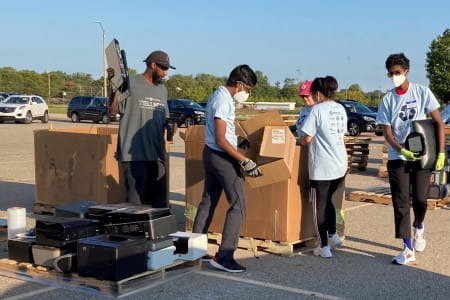
Electronics are made up of materials that can be toxic if released into the environment. Leaded glass, mercury switches, mercury bulbs, brominated flame-retardant plastics, and electronic circuitry made of cadmium, chromium, and lead are among the hazardous elements that can be involved.
Christmas lights are made up of metals such as copper that are readily recycled and made into other products such as more lights or new copper pipes.
According to the World Economic Forum, less than 83% of the electronics generated on an annual basis is collected for recycling and thus is not available to the circular economy to be reused or recycled. When placed in a landfill, waste electronics contribute to heavy metal contamination. Electronics contribute significant amounts of toxic material to landfill leachate and are lost from recycling. That’s why it’s essential to dispose of electronics responsibly.
To keep up with residents’ desire to participate in electronics recycling, EGLE has focused its annual electronics grant program on rural areas of the state. Through the grant program, it has helped communities across Michigan establish local e-waste drop off sites or hold collection events. Multiple permanent electronics collection sites, spread across the rural portions of Michigan, are currently operating. More will be up and running by the spring of 2025.
These collection sites accept unwanted electronics such as computers, printers, cell phones, holiday lights, cables, and more. By working with responsible electronics recyclers, collectors can assure that these products have a reuse opportunity or, at a minimum, are properly recycled to protect the environment.
To find a location to properly recycle unwanted electronic waste and holiday-related electric items such as that old television or holiday lights, check the Michigan Recycling Directory. The manufacturers of certain electronics are required by law to have free takeback program for computers, televisions, and printers. Most meet their requirements by offering free mail-back program. These mail-back programs are easy to use and can be accessed by going to the registered manufacturer's website and searching for recycling information.
For more tips about e-waste recycling, check out EGLE's handy brochure, or contact Steve Noble for more information at [email protected] or 517-449-6153.
Source: EGLE Newsroom

0 notes
Text
Citizen Science Webinars
Gardeners, boaters, off-roaders: NotMISpecies webinars just for you
No matter how you enjoy the outdoors, you’re likely to cross paths with invasive species. Gardeners might find them in the well-manicured shrubs along a walkway. Off-road vehicle enthusiasts can encounter thorny brush along the trails, and boaters face increasing numbers of invasive species fouling motors and limiting access to their favorite waterways.
Michigan’s NotMISpecies webinars are here with the latest information to help clear the way to outdoor enjoyment by showing how to manage and prevent the spread of invasive species, no matter where adventure takes you. Take advantage of these hourlong sessions and engage with experts on emerging issues across the state.
November
Box tree moth (Cydalima perspectalis) was first detected in Michigan in fall 2022. This invasive pest, native to East Asia, poses a major threat to the boxwood plant, an ornamental shrub that is a valuable part of the U.S. (and Michigan) nursery and horticultural industry. Watch the November recorded webinar: Michigan.gov/EGLE/Outreach/Not-MI-Species-Webinar-Series.
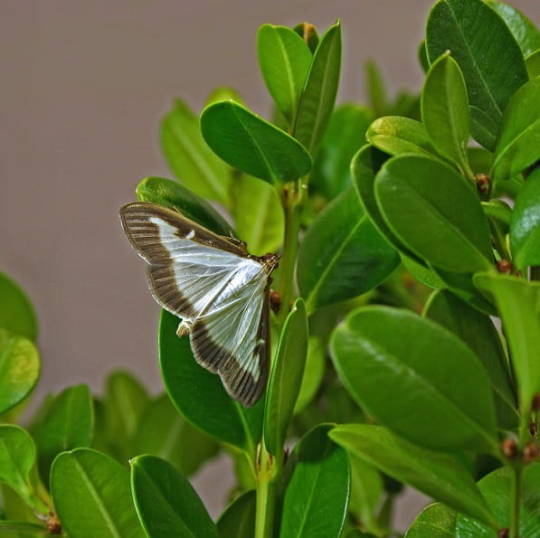
January
In the off-roading world, a muddy 4x4 is a badge of honor, but dirt, mud and trail debris also can carry invasive plant fragments and seeds from one beautiful landscape to another. When the North Country Cooperative Invasive Species Management Area set its sights on educating motorized trail users about the importance of cleaning their vehicles, the question was, “How?” Join Vicki Sawicki, NCCISMA program coordinator, and technician Zach Peklo for “Dirt Never Hurt, but Invasive Species Do – Engaging ORVers to Stop Invasive Spread” (9 a.m. Tuesday, Jan. 23). They will share unique approaches to reaching this transient and fast-moving audience and helping them embrace the beauty of clean rides.

February
European frog-bit was first detected in southeast Michigan in 1996 and has since spread along the coastal areas of lakes Erie, Huron and Michigan and to some inland lakes. Kevin Kapuscinski, associate professor and assistant director of research at Lake Superior State University's Center for Freshwater Research and Education, has been studying the aquatic invasive plant and its effects on native ecosystems and water quality since 2019. In “What’s the Damage? Ecology and Effects of Invasive European Frog-bit in the St. Marys River” (9 a.m. Wednesday, Feb. 7), he will share what’s been learned about plant reproduction, removal efforts and impacts based on research in the St. Marys River in the Upper Peninsula.

Find recordings of all the past NotMISpecies webinars or register for new ones at Michigan.gov/EGLE/Outreach/Not-MI-Species-Webinar-Series.
Source: EGLE Newsroom
0 notes
Text
Nearly 90 percent of the Great Lakes samples have high levels of microplastics
Alliance for the Great Lakes has been protecting, conserving, and restoring our Great Lakes for more than 50 years, and they have no intention of stopping any time soon.
Andrea Densham, Senior Strategic Adviser for Alliance for the Great Lakes, knows that one of the top problems for our Great Lakes is plastic pollution.
A new study conducted by University of Toronto researchers identified that nearly 90 percent of the surface water sampled across the Great Lakes have high levels of microplastics, which are extremely small pieces of plastic that occur in the environment as a consequence of plastic pollution.
Once in the environment, larger pieces of plastic can breakdown into smaller particles by way of several natural weathering processes. There is clear evidence that macroplastics harm individuals, populations, and communities in aquatic ecosystems.
"We estimate that around 22 million pounds enter the Great Lakes annually," said Densham. "Especially from Dr. Rochman’s research, that's probably a drastic underestimation of the amount of plastic that's entering our Great Lakes.”
The amount of microplastics it in the surface water and the Great Lakes is actually in a higher concentration than there is in the Great Pacific Garbage Patch. We think about that being really, really dense and awful. But we actually have higher concentration here in the Great Lakes. And the thing to remember about that is that the Great Lakes is a source of drinking water."
According to Alliance for the Great Lakes, more than 40 million people rely on the Great Lakes for drinking water every day.
Alliance for the Great Lakes has a hand in reducing the amount of plastic through their Adopt-A-Beach volunteer program. In addition to removing the plastic, what they pick up during their volunteer events is converted into data and then sent out to researchers. Alliance for the Great Lakes says that the bottom line is reducing how much plastic we use.
For ways you can help our Great Lakes and volunteer in their Adopt-A-Beach program, visit their website.
Source: Fox17 West Michigan


1 note
·
View note
Text
Don’t toss that pumpkin in the trash: Seven ways to use your pumpkin after Halloween instead of putting it in a landfill
Every year, Americans throw away over 1 billion pounds of pumpkins destined for landfills where they decompose and generate methane gas that contributes to climate change. Michigan produces 79 million pounds of pumpkins every year, ranking fourth in the nation.
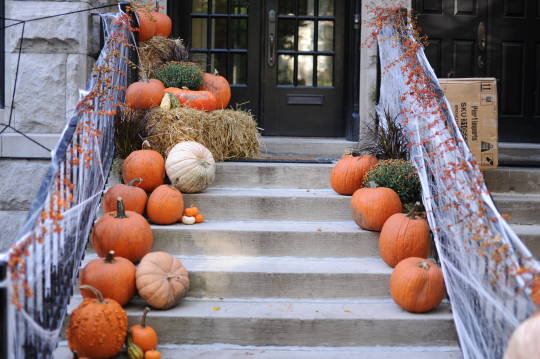
Instead of tossing your whole or jack-o’-lantern pumpkins in the trash, consider these alternatives to use them in a more sustainable way.
Here are seven ways to get more use out of your pumpkins/pumpkin parts:
Bake it and make pumpkin puree to use in baking, cooking, or yummy smoothies!
Make roasted pumpkin seeds.
Donate pumpkins to feed animals. Check with local municipalities, farms, and zoos to see if they can use your pumpkins to feed their animals.
Drop-off pumpkins and jack-o’- lanterns at community collection sites that will compost them. Check with area municipalities and universities for special Halloween-related drop-off sites. Also, check EGLE’s recycling directory that lists locations that take food scraps. (Just type " food scraps" into the field where it says, "What are you looking to recycle?" Before taking your jack-o'-lantern there, be sure to verify the location’s collection details and policies.)
Find a commercial food waste collection service that will pick up pumpkins and other food scraps from your home for composting. Food waste collector My Green Michigan was recently highlighted in an EGLE video.
Make it a tasty snack for wildlife by just letting it be in your garden or a wooded area in your yard.
EGLE Compost Program Coordinator Aaron Hiday encourages Michiganders to compost their pumpkins if they have the space. “You can mix your pumpkins with your fall leaves in a bin to create compost that will help nourish your own soil next spring,” he says. EGLE’s handy guide, Home Composting: Reap a Heap of Benefits, provides helpful information, and more composting tips are highlighted in this EGLE video.
To learn more about composting, visit Michigan.gov/EGLECompost. To learn more about food recovery, visit Michigan.gov/FoodWaste.

Source: EGLE Newsroom
2 notes
·
View notes
Text
Got Leaves? Here's how to dispose of them.
Leaves are falling, Make sure to dispose of them properly.
Source: EGLE: Newsroom
Disposing of yard waste, including grass clippings and leaves, in a lake, river, stream, or wetland is harmful to water quality. It adds excessive phosphorus and can deplete the oxygen in the water, which can kill aquatic animals. It can also impair our ability to recreate, and it harms fish habitat.

Source: https://www.michigan.gov/egle/newsroom/mi-environment/2023/10/11/leaves-are-falling-make-sure-to-dispose-of-them-properly
Under Michigan’s littering law, disposing of yard waste in the water is a civil infraction that can be ticketed by local law enforcement and is punishable with fines from $800 to $5,000 depending on the circumstances. It is also in a violation of Michigan water pollution control regulations, which are enforced by the Michigan Department of Environment, Great Lakes, and Energy (EGLE), and is punishable with much higher fines.
EGLE encourages Michigan residents to compost, schedule pick-up with local waste providers that offer yard waste collection, or find a drop off location for composting yard waste by calling your local municipality, seeing EGLE’s map of registered composters, or searching the Michigan Recycling Directory. Find out more about composting at Michigan.gov/EGLECompost.
The burning of yard waste is considered open burning and may not be allowed by state and local regulations in your area. The burning of trees, logs, brush, and stumps is allowed as long as it is conducted further than 1,400 feet from the boundary of an incorporated city or village and does not cause a nuisance. The open burning of these materials may require a burn permit. Visit Michigan.gov/BurnPermit to find out if one is required in your area. The open burning of grass clippings and leaves is prohibited in any municipality that has a population of 7,500 or more, unless specifically authorized by a local ordinance, which was submitted to EGLE within 30 days of the enactment.
Local ordinances can be more restrictive than state regulations, so it is important to check with your local unit of government for additional open burning restrictions. Local law enforcement can also ticket for open burning under air pollution and waste regulations implemented by EGLE. Learn more about open burning, including the health and environmental hazards associated with open burning, at Michigan.gov/OpenBurning.
1 note
·
View note
Text
Cities across Michigan Focus on Protecting Drinking Water Sources
As part of Source Water Protection Week, (September 24-30) the Michigan Department of Environment, Great Lakes, and Energy (EGLE) is highlighting the efforts of the cities of Gladwin and Harrison to educate students and other about the importance of protecting drinking water sources, with the help of EGLE grants.
Students and others in Gladwin and Harrison are learning about the importance of protecting drinking water – and that means protecting water at its source. Source water includes surface water or groundwater that is used currently – or potentially in the future -- for drinking water.
Gladwin
With the help of an EGLE grant, the City of Gladwin held a banner contest with Gladwin Public Schools, open to K-12 students. The city displayed banners designed by the winners throughout the city, and recognized the winners and gave them source water protection t-shirts.
Also visible around the city are three signs that include information on the water cycle and fun facts on drinking water protection. The signs drive home the message that whatever is dumped on the ground will enter the water cycle.
The City of Gladwin also included participation in the Michigan Wellhead Protection Program in its Consumer Confidence Report that was included in the city’s spring/summer newsletter sent to all residents. The newsletter also included an advertisement for the city’s annual household hazardous waste collection day.
Harrison
The City of Harrison teamed up with the Michigan Rural Water Association to do groundwater model presentations with Harrison Middle School students. Some 101 students saw a demonstration of the groundwater model; made edible “aqui-flurries,” (a fun way to understand the geology of an aquifer); and took a field trip to the well house, water tower, and wastewater lagoons. They learned about the importance of water, groundwater specifics and ways to protect water sources.
The city also hosted a calendar contest with 5th grade students and a t-shirt design contest with 6th through 8th grade students.
Source Water Protection Week focuses on taking a proactive approach to safeguard, maintain or improve the quality and/or the quantity of drinking water sources and their contributing areas. It encourages people to:
Recognize water as a precious resource.
Help conserve the watersheds that are the source of our water.
Protect our shared water resources from pollution.
Practice water conservation.
Become involved in local water issues, and
Plan to protect water for future community health and economic vitality.
Click here to learn more about Source Water Protection Week.
Source: EGLE Newsroom
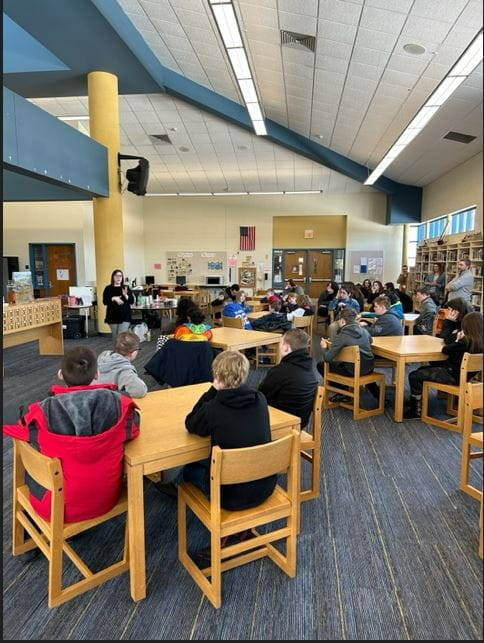

2 notes
·
View notes
Text
EGLE's EnviroSchool for educators is back
EnviroSchool, EGLE Classroom’s webinar series for educators, is back for the 2023-2024 school year with a series of webinars covering community science, climate change, environmental justice, and Great Lakes issues. Register now for Fall 2023 sessions and save the date for winter and spring sessions in 2024.
The EnviroSchool webinar series is geared toward teachers, interpreters, and non-formal environmental educators who want to enhance their teaching with Michigan-based resources. Last year’s sessions focused on the work of each of EGLE’s program divisions to advance EGLE’s mission of protecting human health and the environment through managing air, land, water, and energy resources. This school year’s sessions will focus on EGLE’s efforts to engage the community in our work and to advance environmental policy through the department’s major Offices.
“The EnviroSchool series has given Michigan educators a chance to learn more about the work that EGLE is doing to protect our state’s environment and public health through environmental management,” said Eileen Boekestein, EGLE’s environmental education coordinator. “This helps educators ground student learning in the most important environmental issues facing their own communities and start to see how they can come alongside EGLE to work for environmental sustainability.”
Each webinar in the 2023-2024 series will take place from 4:30-5:30 p.m. and includes presentations from EGLE experts and partner organizations, curriculum connections, and career highlights.
To learn about other environmental education resources and events, subscribe to the EGLE Classroom newsletter and follow #EGLEClassroom on social media.
Registration is open for 2023 EnviroSchool events:
October 10, 2023: Empowering youth through citizen and community science
Join EGLE Classroom as we explore how to empower young people as environmental stewards through the exciting world of citizen science. Learn how 'doing science' in the community both fosters deep understanding of the environment and actively contributes to real-world scientific research. Discover Michigan programs that your classroom, nature center, or youth program can participate in, and gain insights and tips for success from some of EGLE's scientific experts in air, water, and invasive species programs.
December 5, 2023: Think Global, Teach Local: Michigan-based curriculum connections for climate change education
Teaching about global issues like climate change can be hard, but taking a place-based approach can make even the biggest global challenges feel relevant. This EnviroSchool session will highlight some of the biggest climate challenges facing the Great Lakes region, as well as updates regarding some of the major solutions being implemented through EGLE’s Office of Climate and Energy. Educators will learn about statewide efforts to support teaching of climate change education from EGLE, the Michigan Alliance for Environmental and Outdoor Education, and other statewide partners. You’ll also get access to some curated Michigan-specific climate change education resources including a newly updated MEECS Climate Change unit.
Save the date! Registration for 2024 sessions will open in December:
February 8, 2024: Mapping for Justice – Using MiEJScreen to facilitate place-based, problem-based, project-based learning
Basing environmental education on justice-centered phenomena can be a powerful way to support science and engineering learning. Join EGLE Classroom and the Office of the Environmental Justice Public Advocate as we explore how Michigan’s Environmental Justice Screening tool (MiEJScreen) can be used to identify opportunities for place-based learning and youth-led environmental action projects in environmental justice communities.
May 7, 2024: Helping students become stewards with education for Great Lakes literacy
Office of the Great Lakes has worked closely with the MiSTEM Network and Michigan Department of Education to promote the institutionalization of freshwater place-based education in K-12 classrooms across the state over the past three years. Join us to learn about the culmination of this work in the Freshwater Literacy and Stewardship Playbook developed using case studies from this partnership. Learn how to build authentic relationships with community partners that lead to opportunities for action projects that will help your students become stewards of the Great Lakes.

1 note
·
View note
Text
What's being done about plastic trash getting into the Great Lakes?
Plastic pollution is a major concern. Because of the sun and wave action, those bits of plastic break down and become microplastics. Studies over the last few years have documented concentrations of microplastics in fish, in mussels, birds, frogs, drinking water, and Great Lakes beer. And, yes, there are likely microplastic fibers in you.
This month two studies on plastic waste in the Great Lakes were published in the Canadian Journal of Fisheries and Aquatic Sciences. In both studies, the authors advised that it would be helpful if a bi-national agency would give some direction.
The researchers think the quickest way to get things rolling is to amend the Great Lakes Water Quality Agreement between Canada and the U.S.
So the authors of those two studies formally petitioned policy makers to include microplastics as a chemical to be regulated.
The International Joint Commission (IJC) monitors whether Canada and the U.S. are complying with the Great Lakes Water Quality Agreement. It makes recommendations on policy changes to the U.S. and Canadian governments.
Matthew Child is a physical scientist with the IJC. He thought the two studies were helpful. He saw them as affirming the direction the IJC began to examine in 2016. He said before the IJC can make recommendations to the two federal governments, they need a lot more hard data.
“For some, perhaps a rather boring topic of standardizing monitoring methods (is needed) so you can compare the results across jurisdictions, across labs, what's being measured and counted.”
And with that, a case might be made to include microplastics as a “chemical of concern.” That would allow more to be done than just responding to plastics and microplastics in the lakes.
“It's a much more effective strategy to prevent plastics getting into the lakes and into the environment in the first instance than it is to deal with the legacy impacts of those plastics once they get into the environment,” Child said.
Jackson Riegler with Oshki is all in favor of reducing unnecessary use of plastic. But until then, the estimated 22 million pounds of plastic getting into the Great Lakes each year is still washing up on the beaches.
“Ninety percent of Great Lakes plastic actually ends up on beaches. So because of that, it's much more of a grassroots effort. That has to be the approach of the issue. So all the communities in the Great Lakes region have to do their part,” Riegler said.
Source: Bridge Michigan

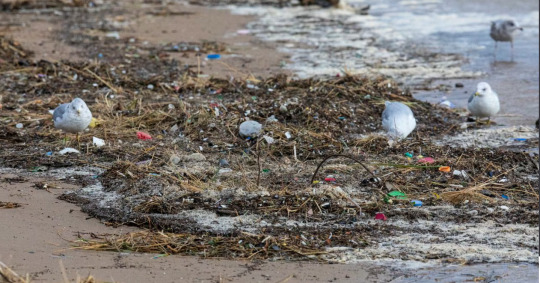
1 note
·
View note